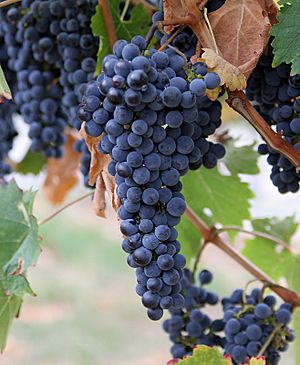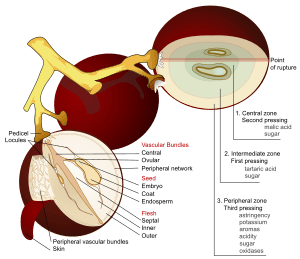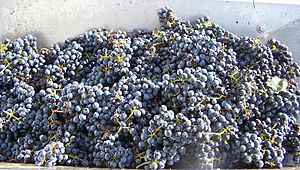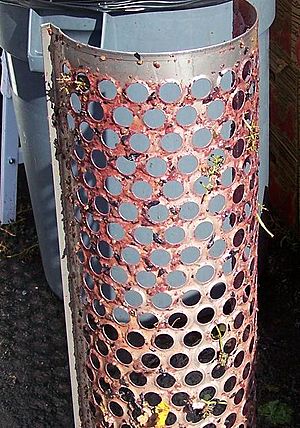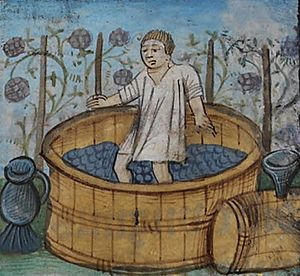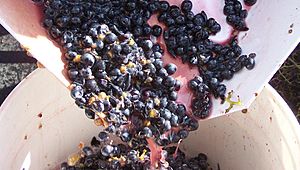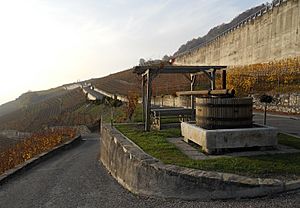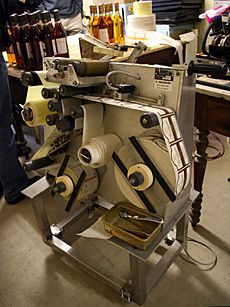Winemaking facts for kids
Winemaking or vinification is the production of wine, starting with the selection of the fruit, its fermentation into alcohol, and the bottling of the finished liquid. The history of wine-making stretches over millennia. The science of wine and winemaking is known as oenology. A winemaker may also be called a vintner. The growing of grapes is viticulture and there are many varieties of grapes.
Winemaking can be divided into two general categories: still wine production (without carbonation) and sparkling wine production (with carbonation – natural or injected). Red wine, white wine, and rosé are the other main categories. Although most wine is made from grapes, it may also be made from other plants. (See fruit wine.) Other similar light alcoholic drinks (as opposed to beer or spirits) include mead, made by fermenting honey and water, and kumis, made of fermented mare's milk.
Contents
Process
There are five basic stages to the wine making process which begins with harvesting or picking. After the harvest, the grapes are taken into a winery and prepared for primary ferment. At this stage red wine making diverges from white wine making. Red wine is made from the must (pulp) of red or black grapes and fermentation occurs together with the grape skins, which give the wine its color. White wine is made by fermenting juice which is made by pressing crushed grapes to extract a juice; the skins are removed and play no further role. Occasionally white wine is made from red grapes; this is done by extracting their juice with minimal contact with the grapes' skins. Rosé wines are either made from red grapes where the juice is allowed to stay in contact with the dark skins long enough to pick up a pinkish color (maceration or saignée), or (less commonly) by blending red wine with white wine. White and rosé wines extract little of the tannins contained in the skins.
To start primary fermentation yeast may be added to the must for red wine or may occur naturally as ambient yeast on the grapes or in the air. Yeast may be added to the juice for white wine. During this fermentation, which often takes between one and two weeks, the yeast converts most of the sugars in the grape juice into ethanol (alcohol) and carbon dioxide. The carbon dioxide is lost to the atmosphere.
After the primary fermentation of red grapes the free run wine is pumped off into tanks and the skins are pressed to extract the remaining juice and wine. The press wine is blended with the free run wine at the winemaker's discretion. The wine is kept warm and the remaining sugars are converted into alcohol and carbon dioxide.
The next process in the making of red wine is malo-lactic conversion. This is a bacterial process which converts "crisp, green apple" malic acid to "soft, creamy" lactic acid softening the taste of the wine. Red wine is sometimes transferred to oak barrels to mature for a period of weeks or months; this practice imparts oak aromas and some tannin to the wine. The wine must be settled or clarified and adjustments made prior to bottling.
The time from harvest to drinking can vary from a few months for Beaujolais nouveau wines to over twenty years for wine of good structure with high levels of acid, tannin or sugar. However, only about 10% of all red and 5% of white wine will taste better after five years than it will after just one year. Depending on the quality of grape and the target wine style, some of these steps may be combined or omitted to achieve the particular goals of the winemaker. Many wines of comparable quality are produced using similar but distinctly different approaches to their production; quality is dictated by the attributes of the starting material and not necessarily the steps taken during vinification.
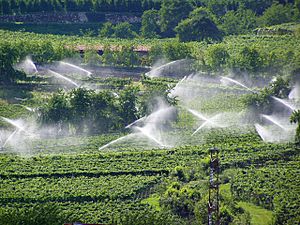
Variations on the above procedure exist. With sparkling wines such as Champagne and Methodé Champenoise (sparkling wine that is fermented in the style of champagne but is not from the Champagne region of France) an additional, "secondary" fermentation takes place inside the bottle, dissolving trapped carbon dioxide in the wine and creating the characteristic bubbles. Additionally, bottles then spend 6 months on a riddling rack before being disgorged to remove any sediment that has accrued. Other sparkling wines, such as prosecco, are fermented using force-carbonation- a faster process that involves using machinery to manually add CO2 and create bubbles. Sweet wines or off-dry wines are made by arresting fermentation before all sugar has been converted into ethanol and allowing some residual sugar to remain. This can be done by chilling the wine and adding sulphur and other allowable additives to inhibit yeast activity or sterile filtering the wine to remove all yeast and bacteria. In the case of sweet wines, initial sugar concentrations are increased by harvesting late (late harvest wine), freezing the grapes to concentrate the sugar (ice wine), allowing or encouraging Botrytis cinerea fungus to dehydrate the grapes or allowing the grapes to raisin either on the vine or on racks or straw mats. Often in these high sugar wines, the fermentation stops naturally as the high concentration of sugar and rising concentration of ethanol retard the yeast activity. Similarly in fortified wines, such as port wine, high proof neutral grape spirit (brandy) is added to arrest the ferment and adjust the alcohol content when the desired sugar level has been reached. In other cases the winemaker may choose to hold back some of the sweet grape juice and add it to the wine after the fermentation is done, a technique known in Germany as süssreserve.
The process produces wastewater, pomace, and lees that require collection, treatment, and disposal or beneficial use.
Synthetic wines, engineered wines or fake wines, are a product that do not use grapes at all and start with water and ethanol and then adds acids, amino acids, sugars, and organic compounds.
The grapes
The quality of the grapes determines the quality of the wine more than any other factor. Grape quality is affected by variety as well as weather during the growing season, soil minerals and acidity, time of harvest, and pruning method. The combination of these effects is often referred to as the grape's terroir. Given the sensitivity of grapes to weather patterns, winemaking is affected by climate change.
Grapes are usually harvested from the vineyard from early September until early November in the northern hemisphere, and mid February until early March in the southern hemisphere. In some cool areas in the southern hemisphere, for example Tasmania, harvesting extends into May.
The most common species of wine grape is Vitis vinifera, which includes nearly all varieties of European origin.
Harvesting and destemming
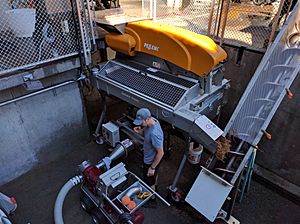
Harvest is the picking of the grapes and in many ways the first step in wine production. Grapes are either harvested mechanically or by hand. The decision to harvest grapes is typically made by the winemaker and informed by the level of sugar (called °Brix), acid (TA or Titratable Acidity as expressed by tartaric acid equivalents) and pH of the grapes. Other considerations include phenological ripeness, berry flavor, tannin development (seed color and taste). Overall disposition of the grapevine and weather forecasts are taken into account.
Mechanical harvesters are large tractors that straddle grapevine trellises and, using firm plastic or rubber rods, strike the fruiting zone of the grapevine to dislodge the grapes from the rachis. Mechanical harvesters have the advantage of being able to cover a large area of vineyard land in a relatively short period of time, and with a minimum investment of manpower per harvested ton. A disadvantage of mechanical harvesting is the indiscriminate inclusion of foreign non-grape material in the product, especially leaf stems and leaves, but also, depending on the trellis system and grapevine canopy management, may include moldy grapes, canes, metal debris, rocks and even small animals and bird nests. Some winemakers remove leaves and loose debris from the grapevine before mechanical harvesting to avoid such material being included in the harvested fruit. In the United States mechanical harvesting is seldom used for premium winemaking because of the indiscriminate picking and increased oxidation of the grape juice. In other countries (such as Australia and New Zealand), mechanical harvesting of premium winegrapes is more common because of general labor shortages.
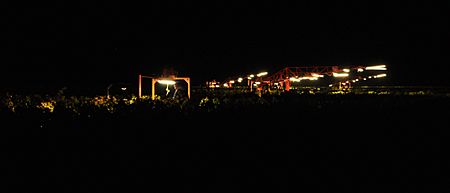
Manual harvesting is the hand-picking of grape clusters from the grapevines. In the United States, some grapes are picked into one- or two-ton bins for transport back to the winery. Manual harvesting has the advantage of using knowledgeable labor to not only pick the ripe clusters but also to leave behind the clusters that are not ripe or contain bunch rot or other defects. This can be an effective first line of defense to prevent inferior quality fruit from contaminating a lot or tank of wine.
Destemming is the process of separating stems from the grapes. Depending on the winemaking procedure, this process may be undertaken before crushing with the purpose of lowering the development of tannins and vegetal flavors in the resulting wine. Single berry harvesting, as is done with some German Trockenbeerenauslese, avoids this step altogether with the grapes being individually selected.
Crushing and primary fermentation
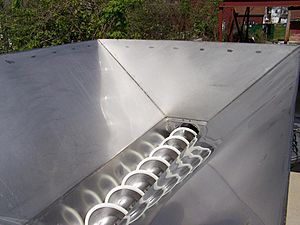
Crushing is the process when gently squeezing the berries and breaking the skins to start to liberate the contents of the berries. Destemming is the process of removing the grapes from the rachis (the stem which holds the grapes). In traditional and smaller-scale wine making, the harvested grapes are sometimes crushed by trampling them barefoot or by the use of inexpensive small scale crushers. These can also destem at the same time. However, in larger wineries, a mechanical crusher/destemmer is used. The decision about destemming is different for red and white wine making. Generally when making white wine the fruit is only crushed, the stems are then placed in the press with the berries. The presence of stems in the mix facilitates pressing by allowing juice to flow past flattened skins. These accumulate at the edge of the press. For red winemaking, stems of the grapes are usually removed before fermentation since the stems have a relatively high tannin content; in addition to tannin they can also give the wine a vegetal aroma (due to extraction of 3-isobutyl-2-methoxypyrazine which has an aroma reminiscent of green bell peppers). On occasion, the winemaker may decide to leave them in if the grapes themselves contain less tannin than desired. This is more acceptable if the stems have 'ripened' and started to turn brown. If increased skin extraction is desired, a winemaker might choose to crush the grapes after destemming. Removal of stems first means no stem tannin can be extracted. In these cases the grapes pass between two rollers which squeeze the grapes enough to separate the skin and pulp, but not so much as to cause excessive shearing or tearing of the skin tissues. In some cases, notably with "delicate" red varietals such as Pinot noir or Syrah, all or part of the grapes might be left uncrushed (called "whole berry") to encourage the retention of fruity aromas through partial carbonic maceration.
Most red wines derive their color from grape skins (the exception being varieties or hybrids of non-vinifera vines which contain juice pigmented with the dark Malvidin 3,5-diglucoside anthocyanin) and therefore contact between the juice and skins is essential for color extraction. Red wines are produced by destemming and crushing the grapes into a tank and leaving the skins in contact with the juice throughout the fermentation (maceration). It is possible to produce white (colorless) wines from red grapes by the fastidious pressing of uncrushed fruit. This minimizes contact between grape juice and skins (as in the making of Blanc de noirs sparkling wine, which is derived from Pinot noir, a red vinifera grape).
Most white wines are processed without destemming or crushing and are transferred from picking bins directly to the press. This is to avoid any extraction of tannin from either the skins or grapeseeds, as well as maintaining proper juice flow through a matrix of grape clusters rather than loose berries. In some circumstances winemakers choose to crush white grapes for a short period of skin contact, usually for three to 24 hours. This serves to extract flavor and tannin from the skins (the tannin being extracted to encourage protein precipitation without excessive Bentonite addition) as well as potassium ions, which participate in bitartrate precipitation (cream of tartar). It also results in an increase in the pH of the juice which may be desirable for overly acidic grapes. This was a practice more common in the 1970s than today, though still practiced by some Sauvignon blanc and Chardonnay producers in California.
In the case of rosé wines, the fruit is crushed and the dark skins are left in contact with the juice just long enough to extract the color that the winemaker desires. The must is then pressed, and fermentation continues as if the winemaker was making a white wine.
Yeast is normally already present on the grapes, often visible as a powdery appearance of the grapes. The primary, or alcoholic fermentation can be done with this natural yeast, but since this can give unpredictable results depending on the exact types of yeast that are present, cultured yeast is often added to the must. One of the main problems with the use of wild ferments is the failure for the fermentation to go to completion, that is some sugar remains unfermented. This can make the wine sweet when a dry wine is desired. Frequently wild ferments lead to the production of unpleasant acetic acid (vinegar) production as a by product.
During the primary fermentation, the yeast cells feed on the sugars in the must and multiply, producing carbon dioxide gas and alcohol. The temperature during the fermentation affects both the taste of the end product, as well as the speed of the fermentation. For red wines, the temperature is typically 22 to 25 °C, and for white wines 15 to 18 °C. For every gram of sugar that is converted, about half a gram of alcohol is produced, so to achieve a 12% alcohol concentration, the must should contain about 24% sugars. The sugar percentage of the must is calculated from the measured density, the must weight, with the help of a specialized type of hydrometer called a saccharometer. If the sugar content of the grapes is too low to obtain the desired alcohol percentage, sugar can be added (chaptalization). In commercial winemaking, chaptalization is subject to local regulations.
Alcohol of more than 12% can be achieved by using yeast that can withstand high alcohol. Some yeasts can produce 18% alcohol in the wine however extra sugar is added to produce a high alcohol content.
During or after the alcoholic fermentation, a secondary, or malolactic fermentation can also take place, during which specific strains of bacteria (lactobacter) convert malic acid into the milder lactic acid. This fermentation is often initiated by inoculation with desired bacteria.
Pressing
Pressing is the act of applying pressure to grapes or pomace in order to separate juice or wine from grapes and grape skins. Pressing is not always a necessary act in winemaking; if grapes are crushed there is a considerable amount of juice immediately liberated (called free-run juice) that can be used for vinification. Typically this free-run juice is of a higher quality than the press juice. Pressed juice is typically lesser in quality due to the release and increase of total phenolic compounds, as well as browning index and the C6-alcohol levels. These compounds are responsible for the herb-like taste perceived in wine with pressed grapes. However, most wineries do use presses in order to increase their production (gallons) per ton, as pressed juice can represent between 15%-30% of the total juice volume from the grape.
Presses act by positioning the grape skins or whole grape clusters between a rigid surface and a movable surface and slowly decrease the volume between the two surfaces. Modern presses dictate the duration and pressure at each press cycle, usually ramping from 0 Bar to 2.0 Bar. Sometimes winemakers choose pressures which separate the streams of pressed juice, called making "press cuts." As the pressure increases the amount of tannin extracted from the skins into the juice increases, often rendering the pressed juice excessively tannic or harsh. Because of the location of grape juice constituents in the berry (water and acid are found primarily in the mesocarp or pulp, whereas tannins are found primarily in the exocarp, or skin, and seeds), pressed juice or wine tends to be lower in acidity with a higher pH than the free-run juice.
Before the advent of modern winemaking, most presses were basket presses made of wood and operated manually. Basket presses are composed of a cylinder of wooden slats on top of a fixed plate, with a moveable plate that can be forced downward (usually by a central ratcheting threaded screw). The press operator would load the grapes or pomace into the wooden cylinder, put the top plate in place and lower it until juice flowed from the wooden slats. As the juice flow decreased, the plate was ratcheted down again. This process continued until the press operator determined that the quality of the pressed juice or wine was below standard, or all liquids had been pressed. Since the early 1990s, modern mechanical basket presses have been revived through higher-end producers seeking to replicate the gentle pressing of the historical basket presses. Because basket presses have a relatively compact design, the press cake offers a relatively longer pathway for the juice to travel before leaving the press. It is believed by advocates of basket presses that this relatively long pathway through the grape or pomace cake serves as a filter to solids that would otherwise affect the quality of the press juice.
With red wines, the must is pressed after primary fermentation, which separates the skins and other solid matter from the liquid. With white wine, the liquid is separated from the must before fermentation . With rose, the skins may be kept in contact for a shorter period to give color to the wine, in that case the must may be pressed as well. After a period in which the wine stands or ages, the wine is separated from the dead yeast and any solids that remained (called lees), and transferred to a new container where any additional fermentation may take place.
Pigeage
Pigeage is a French term for the management of acidity and secondary pressing of grapes in fermentation tanks. To make certain types of wine, grapes are put through a crusher and then poured into open fermentation tanks. Once fermentation begins, the grape skins are pushed to the surface by carbon dioxide gases released in the fermentation process. This layer of skins and other solids is known as the cap. As the skins are the source of the tannins, the cap needs to be mixed through the liquid each day, or "punched," which traditionally is done by stomping through the vat.
Cold stabilization
Cold stabilization is a process used in winemaking to reduce tartrate crystals (generally potassium bitartrate) in wine. These tartrate crystals look like grains of clear sand, and are also known as "wine crystals" or "wine diamonds". They are formed by the union of tartaric acid and potassium, and may appear to be [sediment] in the wine, though they are not. During the cold stabilizing process after fermentation, the temperature of the wine is dropped to close to freezing for 1–2 weeks. This will cause the crystals to separate from the wine and stick to the sides of the holding vessel. When the wine is drained from the vessels, the tartrates are left behind. They may also form in wine bottles that have been stored under very cold conditions.
Secondary (malolactic) fermentation and bulk aging
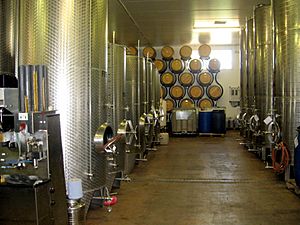
During the secondary fermentation and aging process, which takes three to six months, the fermentation continues very slowly. The wine is kept under an airlock to protect the wine from oxidation. Proteins from the grape are broken down and the remaining yeast cells and other fine particles from the grapes are allowed to settle. Potassium bitartrate will also precipitate, a process which can be enhanced by cold stabilization to prevent the appearance of (harmless) tartrate crystals after bottling. The result of these processes is that the originally cloudy wine becomes clear. The wine can be racked during this process to remove the lees.
The secondary fermentation usually takes place in large stainless steel vessels with a volume of several cubic meters, oak barrels or glass demijohns (also referred to as carboys), depending on the goals of the winemakers. Unoaked wine is fermented in a barrel made of stainless steel or other material having no influence on the final taste of the wine. Depending on the desired taste, it could be fermented mainly in stainless steel to be briefly put in oak, or have the complete fermentation done in stainless steel. Oak could be added as chips used with a non-wooden barrel instead of a fully wooden barrel. This process is mainly used in cheaper wine.
Amateur winemakers often use glass carboys in the production of their wine; these vessels (sometimes called demijohns) have a capacity of 4.5–54 litres (0.99–11.88 imp gal; 1.2–14.3 US gal). The kind of vessel used depends on the amount of wine that is being made, the grapes being used, and the intentions of the winemaker.
Malolactic fermentation
Malolactic fermentation occurs when lactic acid bacteria metabolize malic acid and produce lactic acid and carbon dioxide. This is carried out either as an intentional procedure in which specially cultivated strains of such bacteria are introduced into the maturing wine, or it can happen by chance if uncultivated lactic acid bacteria are present.
Malolactic fermentation can improve the taste of wine that has high levels of malic acid, because malic acid, in higher concentration, generally causes an unpleasant harsh and bitter taste sensation, whereas lactic acid is more gentle and less sour.
Laboratory tests
Whether the wine is aging in tanks or barrels, tests are run periodically in a laboratory to check the status of the wine.
Blending and fining
Different batches of wine can be mixed before bottling in order to achieve the desired taste. The winemaker can correct perceived inadequacies by mixing wines from different grapes and batches that were produced under different conditions. These adjustments can be as simple as adjusting acid or tannin levels, to as complex as blending different varieties or vintages to achieve a consistent taste.
Fining agents are used during winemaking to remove tannins, reduce astringency and remove microscopic particles that could cloud the wines. The winemakers decide on which fining agents are used and these may vary from product to product and even batch to batch (usually depending on the grapes of that particular year).
Gelatin [gelatine] has been used in winemaking for centuries and is recognized as a traditional method for wine fining, or clarifying. It is also the most commonly used agent to reduce the tannin content. Generally no gelatin remains in the wine because it reacts with the wine components, as it clarifies, and forms a sediment which is removed by filtration prior to bottling.
Besides gelatin, other fining agents for wine are often derived from animal products, such as micronized potassium caseinate (casein is milk protein), egg whites, egg albumin, bone char, bull's blood, isinglass (Sturgeon bladder), PVPP (a synthetic compound), lysozyme, and skim milk powder. Although not common, finely ground eggshell is also sometimes used.
Some aromatized wines contain honey or egg-yolk extract.
Non-animal-based filtering agents are also often used, such as bentonite (a volcanic clay-based filter), diatomaceous earth, cellulose pads, paper filters and membrane filters (thin films of plastic polymer material having uniformly sized holes).
Preservatives
The most common preservative used in winemaking is sulfur dioxide (SO2), normally added in one of the following forms: liquid sulfur dioxide, sodium or potassium metabisulphite. Another useful preservative is potassium sorbate.
Filtration
Filtration in winemaking is used to accomplish two objectives, clarification and microbial stabilization. In clarification, large particles that affect the visual appearance of the wine are removed. In microbial stabilization, organisms that affect the stability of the wine are removed therefore reducing the likelihood of re-fermentation or spoilage.
The process of clarification is concerned with the removal of particles; those larger than 5–10 millimetres (0.20–0.39 in) for coarse polishing, particles larger than 1–4 micrometers for clarifying or polishing. Microbial stabilization requires a filtration of at least 0.65 micrometers for yeast retention and 0.45 µm for bacteria retention. However, filtration at this level may lighten a wine's color and body. Microbial stabilization does not imply sterility, i.e. eliminating (removing) or killing (deactivating) of all forms of life and other biological agents. It simply means that a significant amount of yeast and bacteria has been removed to a harmless level for the wine stability.
Clarification of the wine can take place naturally by putting the wine into refrigeration at 35 °F (2 °C). The wine takes about a month to settle and it is clear. No chemicals are needed.
Biodynamic
Biodynamic wines are wines made employing the biodynamic methods both to grow the fruit and during the post-harvest processing. Biodynamic wine production uses organic farming methods (e.g. employing compost as fertilizer and avoiding most pesticides) while also employing soil supplements prepared according to Rudolf Steiner's formulas, following a planting calendar that depends upon astrological configurations, and treating the earth as "a living and receptive organism."
Bottling
A final dose of sulfite is added to help preserve the wine and prevent unwanted fermentation in the bottle. The wine bottles then are traditionally sealed with a cork, although alternative wine closures such as synthetic corks and screwcaps, which are less subject to cork taint, are becoming increasingly popular. The final step is adding a capsule to the top of the bottle which is then heated for a tight seal.
Winemakers
Traditionally known as a vintner, a winemaker is a person engaged in making wine. They are generally employed by wineries or wine companies, although there are many independent winemakers who make wine at home for their own pleasure or small commercial operation. Additionally, winemaking is still carried in traditional ways by families producing wine for their own consumption.
List of top 15 wine producing countries by volume. (Volume in thousands of hectoliters)
| Country | 2010 | 2011 | 2012 | 2013 | 2014 | 2015 | 2016 | 2017 | 2018 |
|---|---|---|---|---|---|---|---|---|---|
| 48,525 | 42,772 | 45,616 | 52,029 | 44,739 | 50,000 | 50,900 | 42,500 | 48,500 | |
| 44,381 | 50,757 | 41,548 | 42,004 | 46,698 | 47,000 | 45,200 | 36,600 | 46,400 | |
| 35,353 | 33,397 | 31,123 | 45,650 | 41,620 | 37,700 | 39,300 | 32,500 | 40,900 | |
| 20,887 | 19,140 | 21,650 | 23,590 | 22,300 | 21,700 | 23,600 | 23,300 | 23,900 | |
| 16,250 | 15,473 | 11,778 | 14,984 | 15,197 | 13,400 | 9,400 | 11,800 | 14,500 | |
| 11,420 | 11,180 | 12,260 | 12,500 | 12,000 | 11,900 | 13,100 | 13,900 | 12,500 | |
| 9,327 | 9,725 | 10,569 | 10,982 | 11,316 | 11,200 | 10,500 | 10,800 | 9,500 | |
| 13,000 | 13,200 | 13,511 | 11,780 | 11,178 | 11,500 | 11,400 | 11,400 | 10,800 | |
| 8,844 | 10,464 | 12,554 | 12,820 | 10,500 | 12,900 | 10,100 | 9,500 | 12,900 | |
| 6,906 | 9,132 | 9,012 | 8,409 | 9,334 | 8,900 | 9,000 | 7,500 | 9,800 | |
| 7,148 | 5,622 | 6,308 | 6,237 | 6,195 | 7,000 | 6,000 | 6,700 | 5,300 | |
| 3,287 | 4,058 | 3,311 | 5,100 | 3,700 | 3,600 | 3,300 | 4,300 | 5,200 | |
| 6,400 | 6,353 | 6,400 | 5,300 | 4,900 | 5,600 | 5,200 | 4,700 | 4,700 | |
| - | - | - | 2,600 | 2,400 | 2,600 | 2,500 | 2,500 | 3,400 | |
| Rest of the World | 27,847 | 30,906 | 27,194 | 31,000 | 27,100 | 29,800 | 29,900 | 30,900 | 30,700 |
| World | 264,425 | 267,279 | 257,889 | 290,100 | 270,000 | 277,000 | 273,000 | 251,000 | 282,000 |
See also
 In Spanish: Producción del vino para niños
In Spanish: Producción del vino para niños


